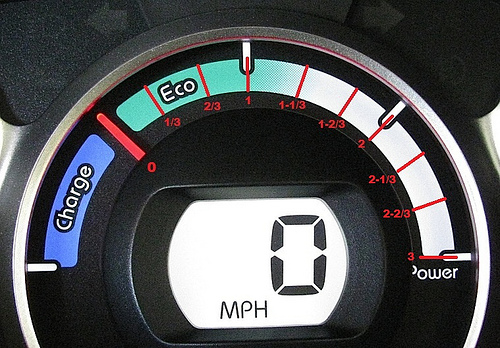By far, the largest number of questions received regarding the iMiEV deals with RANGE. For the iMiEV, range has NOT been empirically quantified. The simplistic EPA ratings is all we presently have available, and some of us have a problem with their numbers.
Intuitively, we iMiEV drivers recognize that going fast disproportionately decreases our Range Remaining; conversely, slowing down disproportionately slows down the decrease of our Range Remaining. It sure as heck is not linear! Technically, we of course recognize that drag is proportional to the square of the vehicle's velocity.
Trouble is, we don't have these numbers, and thus I am soliciting the help of all the iMiEV drivers out there.
jjlink was kind enough to modify the photo of the iMiEV power gauge to show divisions that should be easy to assess by eyeball: breaking up each division into "thirds" ("Quarters" was felt to be too fine a division).

Now, here's what I would like us all to do: while driving our iMiEVs on a flat level windless surface and holding it steady with the red needle at a particular point, it would be great if you could record the vehicle's SPEED vs. red needle POSITION. If you could each do this for as many points as are realistically feasible for you (without breaking any laws) and I would appreciate it if you could then send the data to me.
Originally, I thought we could each publicly post our data, but in the interest of avoiding being influenced by others' data I would appreciate it if each of you could PM (Private Message) me the data directly, by simply clicking on PM at the bottom of this post.
What I will then do is compile this information into a spreadsheet with datapoints and then perform a nonlinear regression analysis to end up with a curve of SPEED vs. POWER GAUGE LEVEL which of course I'll publish. If you'd like, I could also publish the anonymized raw data y'all sent in.
This will now form the basis for quantifying our RANGE vs. SPEED (with perhaps some discussion about things like voltages and Peukert prior to that).
OK, if there are any questions then let's get them out in the open on this thread, and in the meantime I'd appreciate all your help in getting the data to me. I think you'll find that it is not as simple as it sounds to hold the car at a steady speed in zero wind on a flat level surface... but please try, and I realize this may take some time to accomplish for us to get sufficient data. I found that using a voice recorder works well for capturing this information.
Thank you for your help.
Intuitively, we iMiEV drivers recognize that going fast disproportionately decreases our Range Remaining; conversely, slowing down disproportionately slows down the decrease of our Range Remaining. It sure as heck is not linear! Technically, we of course recognize that drag is proportional to the square of the vehicle's velocity.
Trouble is, we don't have these numbers, and thus I am soliciting the help of all the iMiEV drivers out there.
jjlink was kind enough to modify the photo of the iMiEV power gauge to show divisions that should be easy to assess by eyeball: breaking up each division into "thirds" ("Quarters" was felt to be too fine a division).

Now, here's what I would like us all to do: while driving our iMiEVs on a flat level windless surface and holding it steady with the red needle at a particular point, it would be great if you could record the vehicle's SPEED vs. red needle POSITION. If you could each do this for as many points as are realistically feasible for you (without breaking any laws) and I would appreciate it if you could then send the data to me.
Originally, I thought we could each publicly post our data, but in the interest of avoiding being influenced by others' data I would appreciate it if each of you could PM (Private Message) me the data directly, by simply clicking on PM at the bottom of this post.
What I will then do is compile this information into a spreadsheet with datapoints and then perform a nonlinear regression analysis to end up with a curve of SPEED vs. POWER GAUGE LEVEL which of course I'll publish. If you'd like, I could also publish the anonymized raw data y'all sent in.
This will now form the basis for quantifying our RANGE vs. SPEED (with perhaps some discussion about things like voltages and Peukert prior to that).
OK, if there are any questions then let's get them out in the open on this thread, and in the meantime I'd appreciate all your help in getting the data to me. I think you'll find that it is not as simple as it sounds to hold the car at a steady speed in zero wind on a flat level surface... but please try, and I realize this may take some time to accomplish for us to get sufficient data. I found that using a voice recorder works well for capturing this information.
Thank you for your help.























